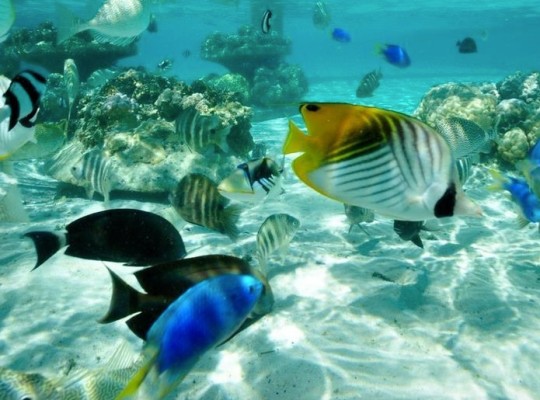Whether Captain Cook Monument at Kealakekua Bay, Two Steps at Honaunau Bay, Kahalu‘u Beach in Kailua-Kona, or the tide pools at Kapoho, the Big Island of Hawaii‘i provides some of the most stellar snorkeling spots in the entire state. For visitors and residents alike, the ultimate snorkeling experience can be had when you don the right equipment and know what you’re doing.
When choosing the right snorkel mask, the most important consideration is a good fit. The mask must fit the face properly in order to retain a good seal. The best way to check if a mask is right for you is to place the mask on your face and inhale through the nose. If the mask stays on your face on its own, it probably has a good seal. A common mistake with beginners is to pull the mask too tight, however. This will unnecessarily flatten the mask, which compromises the seal and can create potential leaks.

Using a defogger on your mask before entering the water will enhance the mask’s visibility. Good defogging products are available, but there’s a free and convenient method growing right on most Big Island beaches: the leaves of the naupaka plant. Just break off two leaves and crush them together, then rub the sap onto the mask for a fine film that lasts. Unlike commercial defoggers, naupaka sap is not petroleum based, so it won’t pollute the water.
A simple snorkel and mask setup will do the trick for the occasional snorkeler, but if you are really interested in a peak experience, opt for top-of-the-line equipment. The best place to purchase snorkel gear in Kona is at Jack’s Diving Locker. In the mask department, there are choices like prescription lens masks, magnification devices for close-up vision and special masks designed for men with mustaches. In the snorkel department, there are dry or semi-dry snorkels that prevent water from entering the snorkel. Bendable snores can be folded and stuffed in your pocket. Beginning snorkelers can benefit from the dry snorkel made with a valve that prohibits water from entering and eliminates the need to purge excess water out of the snorkel. The semi-dry snorkel has vents at the top that help purge water.
For increased propulsion, split fins can really make a difference. Made with an open split down the blade, these types of fins reduce turbulence and drag in the water. Not only are they hydrodynamic, they are also easy on the leg and foot muscles after a long session in the water. The open-heeled fin is more expensive and can be used for diving as well. A good rule of thumb: the stronger the fin, the faster the propulsion.
The word “snorkel” comes from the German word “schnoerkel,” which was a tube used by German submarine crews in World War II to feet air from the surface of the water into the diesel engines. Snorkeling in the ocean dates back thousands of years. Some of the earliest-known free divers were sponge farmers in Crete, who used hollow reeds as breathing apparatuses.
One of the most important considerations when snorkeling is to familiarize yourself with the area before entering the water. If you lack confidence in the water, use a swim noodle to give you extra floatation. Always be aware of your surroundings and don’t drift out of your comfort zone. Keep hydrated before snorkeling and wear a rash guard. Be mindful of the ecology of the ocean. Don’t step on coral or feed the fish. Keep your gear well maintained and rinse in fresh water after every use. Don’t leave your gear in the sun to prevent silicon breakdown. Most importantly, enjoy the unforgettable sights of Hawaii‘i’s incredible reefs, shores, beaches and bays.

